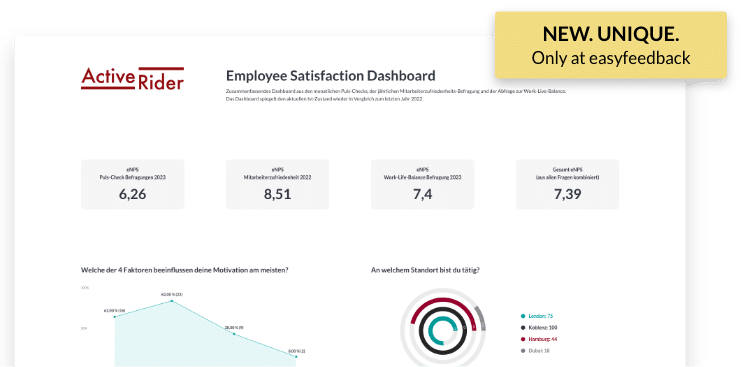Are your employees satisfied with working from home? Find out.

With this ready-made survey template, you can ask your employees about their current situation and satisfaction working from home. Identify any problems and ensure the availability of the required work equipment.

“Identifying customer needs is an essential part of our business. easyfeedback accompanies us for many years as a loyal partner in this task. We particularly appreciate the intuitive usability of the survey tool as well as the professional support.“
Guild Lead User Experience Research

“We use easyfeedback for internal and external surveys – fast, comfortable and really easy! Straightforward and cordial support can always create a smile. We really appreciate the permanent development of the platform.“
Guest & Competitor Insights Analyst
Content and targets of this working from home satisfaction template
The Corona pandemic has presented challenges for many companies. To adapt to this extraordinary situation, many companies have given their employees the opportunity to work from home. This circumstance has not only given new impetus to the topic in the short term, but also shows great potential to make working from home the norm in the future.
Although working from home offers advantages, it can lead to a wide variety of problems for some people due to changes in work processes or private circumstances, and can have a negative impact on work productivity. That’s why it’s even more important to show your employees that you’re there for them, not only during the adjustment phase, but also on a permanent basis.
From time to time, inquire about employee satisfaction, whether all resources are available to complete tasks, or whether communication and cooperation with colleagues and supervisors can be improved.
Filter out specific problems in order to improve working from home and promote it in a goal-oriented manner.
Content:
• Query current sentiment
• Inquiry about available equipment
• Evaluate communication and collaboration
• Inquiry about productivity
Goals:
• Increase employee satisfaction & motivation
• Improve teamwork & work atmosphere
• Improve work equipment
• Identify problems during working from home

Data privacy protection „made in Germany“ (GDPR)

Anonymity functions for open feedback
Almost everything you need to know about working from home
1. What is meant by working from home?
Working from home simply means that a company gives its employees the opportunity to work flexibly from home. With the help of digital technologies for communicating with each other, such as e-mails or video calls, working from home is an effective and useful alternative to the traditional workplace.
But not all types of working from home are the same. In the meantime, there are many different forms of homeworking. The type depends on the extent to which the employee works from home.
On the one hand, home office can be carried out full-time, which means that the employee works exclusively from home and does not have a permanent workplace at the office.
On the other hand, home office can also be designed alternately. Accordingly, the employee works alternately at the on-site job and from home and thus has a workplace at both locations.
Furthermore, there is also the type of location-independent working. In this type of work, the employee does not have a fixed workstation either at the office or at home. His workplace moves with him, so to speak. This mobile type of work is common among employees who travel a lot or for whom business trips are on the daily list.
2. What are the advantages of working from home for companies?
Not only for employees, but also for the companies, offering working from home can offer some advantages. In the following, we have explained the most important advantages for you:
1. Strengthen employer brand
For a company, offering homeworking has the advantage of strengthening its own employer brand. The reason for this is as follows: working from home is becoming more and more in demand, not only among job seekers, but also among employees themselves.
Especially for employees who want to reconcile family and career, this flexible form of work proves to be very attractive, which strengthens employee satisfaction and retention. As a result, home offices help to reduce the fluctuation rate and save companies the costly recruiting and training of new employees.
2. Turbo for recruiting
Jobs for which working from home is offered are in high demand and can make it easier to recruit new employees.
By offering the possibility, companies can additionally increase the radius for finding suitable employees and thus no longer have to limit themselves based on location. Recruitment can thus be extended to the entire country and, if desired, even internationally.
This fact provides companies with the opportunity to discover and attract new talent that would otherwise be impossible to employ for local reasons.
3. Increase in productivity
Working from home can develop a more productive work style due to the elimination of private conversations among colleagues and a less distracting noise environment. At home, less distracted in a more comfortable environment, employees can do not only faster work, but better work.
Although it is also possible that employees feel distracted due to the presence of other family members or the household within their own four walls and cannot clearly separate private life and work, which leads to a less productive way of working, it can be seen from various studies, for example by the german DAK or the Fraunhofer Institute , that this does not affect the majority.
Most employees benefit from the possibility to work from home and generally feel more balanced, which has a positive effect on the quality of their work. By working more efficiently, better end results follow, which in turn can lead to more satisfied customers and higher sales for the company.
4. Punctuality and fewer breakdowns
Employees are stuck in traffic jams, the train is late or the weather is not cooperating. These are all reasons why employees are regularly late for work. This doesn’t happen in homeworking. Since the stressful commute is completely eliminated, punctuality should no longer be a problem and employees can get straight to work.
In addition, working from home can reduce the number of sick days. For example, since employees stay home when they have a slight cold, on the one hand to avoid stressful commutes and on the other to reduce the risk of infection in the office, employees in the home office may still be willing to sit down at work for a few hours. Or they may return from sick leave more quickly than they otherwise would have.
Accordingly, there may be less missed work. It is also possible to care for sick children or relatives in need of care in addition to the home office without having to call in sick.
Since employees generally feel more balanced due to improved work-life balance and can combine family, career and leisure time, the need for compensatory time off can be reduced. Home office also makes it easier for employees to return to work after parental leave or maternity leave.
5. Cost savings for companies
In terms of costs, companies can have financial savings by offering home office to employees.
Accordingly, since employees who work from home do not need on-site workstations, office space and thus rental costs are saved by downsizing the office. Incidental costs such as drinks for employees, additional office equipment or electricity consumption are reduced or eliminated completely.
3. What advantages does working from home offer employees?
As mentioned earlier, employees also gain some benefits from working from home:
Fewer distractions, more concentrated work phases and a familiar work environment; these factors can promote an increase in productivity. This is because employees who work from home are less distracted by the lack of private exchanges among colleagues or a lower noise level. They work in a more focused, concentrated manner and may be more motivated by working from home, which affects the quality of their work.
Furthermore, homeworking offers an improved work-life balance due to the more flexible working hours. Depending on the regulations in the company, it is possible that only the core working hours have to be adhered to, which is why it is somewhat easier to combine work with family. Taking care of children or caring for relatives can happen alongside the home office.
Finding a good balance between private life and work is becoming increasingly important for employees. If this is given, it leads to greater job satisfaction.
Like companies, employees can save money by working from home. Since the commute is eliminated, so are the costs for gasoline or tickets for public transportation.
The daily commute in rush hour traffic or waiting for delayed buses or trains builds up stress and eats up time first thing in the morning. Thanks to the home office, this stress is reduced and time is gained, which is why employees can get straight to work with a freer head.
4. Why should companies conduct satisfaction surveys for homeworking?
In addition to fulfilling basic business functions, a company’s tasks also include taking care of its employees and providing them with an appropriate workplace.
In order to fulfill this task as well, companies should regularly gather feedback from their employees about their satisfaction, productivity and the quality of the work resources provided.
Feedback via a survey provides a great platform for employees to share what is going well in the home office and what needs to be improved.
If the circumstances are right and potential problems and obstacles are solved, employees will feel so comfortable that this will have an impact on their satisfaction and motivation when working from home.
5. What questions can I ask in a working from home satisfaction survey?
First and foremost, a satisfaction survey for homeworking purpose should provide a picture of the current mood of employees. Questions such as “Are you satisfied with your workday at home?” or “Do you find a good balance between work and free time?” are a good starting point and are usually enough to get a rough idea of how working from home is received by employees and whether they can cope with it.
Next, you should ask questions about work equipment. In order for employees to be able to do their jobs well from home, employers need to make sure they are not lacking for anything and that the work equipment provided is working at its best.
Questions such as, “Do you have all the resources they need to complete your tasks?” or “Are your provided work tools functioning properly or are there problems?” will give you insight to provide any missing work tools or replace work equipment.
Good communication is especially important when working from home is offered. Since employees otherwise have no other points of contact with their colleagues except via provided digital communication tools, these should also function faultlessly. Of course, good accessibility of all employees and supervisors should be out of the question.
A short check-up with questions such as: “How do you rate the communication and accessibility among colleagues and superiors?” or “How do you rate the quality and efficiency of our online meetings?” helps to continuously optimize digital communication options and to stay informed about the functionality at all times.
To finish the survey, you can ask questions about the employee’s productivity. There are some employees who are able to work more focused in a home office than in an office. Others find that the potential for distraction is higher possibly due to their own children or household in the home office.
Questions such as, “Is your productivity higher at home or in an office?” or “Does homeworking allow you to work in a more concentrated atmosphere?” can help to find the optimal form of work for each employee.
You are in professional company







easyfeedback welcomes more than 740.000 participants per month







